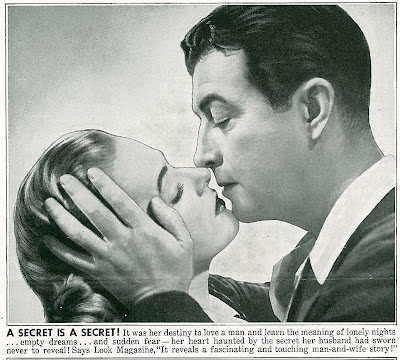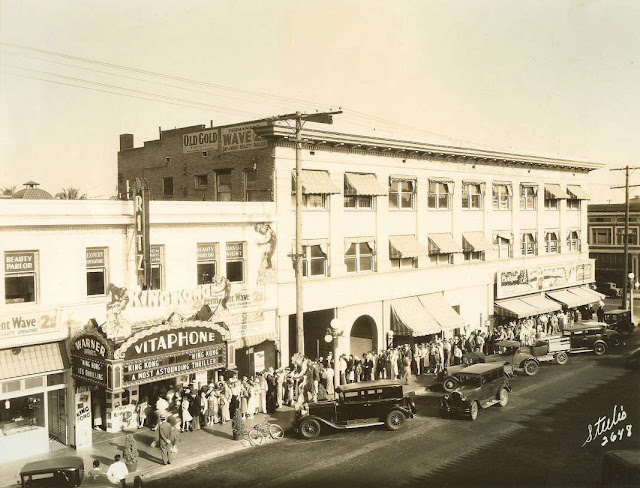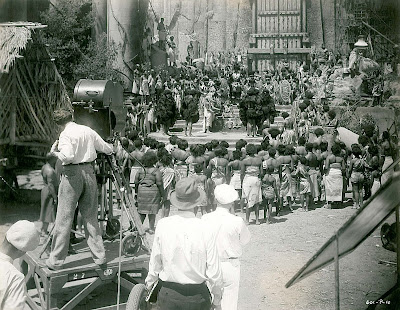


Atom bombs are most effective in movies when they unleash dinosaurs, krakens, or mutant ants. Serious exploration of the Bomb and its applications are tougher to dramatize. Get technical with audiences and they switch off. Argue moral implications and you’ll empty theatres. Metro found out with a 1947 go at the Manhattan Project that ended with losses of $1.5 million. The Beginning Or The End may have been too close to the actual drop for comfort. Many spoonfuls of sugar were needed to make this medicine go down. When time came to dramatize the mission of Lt. Colonel Paul Tibbetts, the pilot who flew over Hiroshima, MGM knew better which blueprint to use. Thirty Seconds Over Tokyo wasn’t about atom bombs, but its set-up worked to a tune of $1.4 million in 1944 profits, and could easily be modified for 1952 application. Above and Beyond was less about the Bomb and more about secrets its architects kept from their wives. Putting over a story like this required getting out of laboratories and into kitchens. Telling it all from a woman’s viewpoint would cinch the deal. Metro marketing know-how followed up on cunning writers-directors Norman Panama and Melvin Frank’s shift of emphasis from nuclear force to the force of nuclear families, by far the greater concern of audiences done with war and disinclined to revisit one of its darker chapters.


Writers were hot to get Enola Gay off the ground again since Col. Tibbetts lent technical expertise to the novel that became Twelve O’Clock High. He had appeared by (minor) way of actor Barry Nelson among characters in The Beginning Or The End. Tibbetts was a natural and his Air Force superiors were ready to team with Metro to reveal the Best Kept Secret Of The War. Figured early was the importance of Tibbett’s personal story. Not only was this the better commercial option, it would also boost morale within the Strategic Air Command, where divorce rates among pilots were climbing higher than planes they were flying. If the Tibbetts could withstand pressures brought by so monumental a project as the Atom Bomb, surely military personnel in the audience could put right their own marital discords. You don’t find a lot of romance in war, said Tibbetts, but Metro was determined to shoehorn plenty into Above and Beyond. Recognition of this inspired him to beg off on the studio’s offer to serve as technical advisor. I was too close to the forest to see the trees, said Tibbetts, who did at least approve of Robert Taylor as his screen altar-ego. They got on well, and Tibbetts admired the fact that Taylor had actually served in the military. The Colonel evinced little interest or confidence in war movies. They’re a bunch of bullshit, he said. I found out right away that they took liberties. They made things up. Things about the flight --- at first I felt like correcting them, but they explained to me that this is the way movies work. To make it more entertaining, and to make it move along. So I just accepted that, and watched it as a movie. Like most men of action, Tibbetts cared less about Hollywood in any case. He’d never see Thirty Seconds Over Tokyo, The Best Years Of Our Lives, or the much later Saving Private Ryan. He was impatient with actors and their yak-yak. There’s no use in wasting a lot of damn words when you can do something instead. MGM writers sought to lay a major guilt complex on the Tibbetts character over Hiroshima and weave the show around that, but military brass resisted. It was enough giving them marital strife to chew on, and Tibbetts, who had veto power over degrading and misleading aspects of any script, was surprisingly compliant over dramatization of his domestic woes. He’d later reveal that Above and Beyond really didn’t portray the tensions as bad as they were (the Tibbetts would divorce in 1955). As to guilt, he’d feel none. It was the Colonel’s job and he did it, a position Tibbetts would maintain right up to November 1, 2007, the date of his death at 92. If you give me the same circumstances, hell yeah, I'd do it again.




A love story with tenderness and heartbreak. Ladies, take a couple of hankies with you. You’ll need them, warns Hedda Hopper at the trailer’s conclusion. Above and Beyond was designed to serve its women customers first. Metro’s boxoffice was dependent upon that. The less discussion about bombs the better, lest the show itself bomb, and no need getting excited about planes switching from shot to shot, or staging the Enola Gay’s take-off in daytime when the actual flight left at night. Such nitpicking was confined to war buffs and kids that built airplane models, and besides, Girlfriend and Mom made the decisions about what they’d all go to see. 1952 was long before moviegoing became the near exclusive province of adolescent boys. Pictures lacking femme interest paid for such oversight in (lost) turnstile dollars. Above and Beyond had trouble enough for action minimized in favor of interior drama. This topic was too serious to tread lightly upon. You’d not have the turkey shoot pay-off of a Sergeant York or bombs taking out picturesque factory models as in Thirty Seconds Over Tokyo. There could be no exhilaration when this payload was dropped. Downplaying the devastation avoided downer exits and bad word of mouth. Stars Robert Taylor and Eleanor Parker helped overcome audience dread of the subject matter, plus there was genuine fascination with long delayed unraveling of what had gone on in connection with the military’s biggest hush-hush operation. Fullest Air Force cooperation guaranteed positive depiction of all service branches. Taylor/Tibbetts readjusts a few brass hats with character establishing insubordination during the first act, but that’s to reassure us that he’s the right guy for this mission. Scientists at the top-secret base are tentative eggheads who’d sooner scuttle the project than gamble on its success, typical of movie intellectuals whose usefulness ends when bugles sound.



The US Air Force got on merchandising board with Metro and pushed recruitment in lobbies nationwide. Are you tough enough to go "Above and Beyond"? Uniformed personnel stationed or residing nearby would be encouraged to attend local openings, and Air Force bands were available, provided the band’s appearance constitutes a part of a serious, dignified, semi-civic ceremony. Original crewmembers from the Enola Gay participated in the campaign. MGM’s pressbook actually listed home addresses for a number of them and advised exhibitors in those areas to make contact for possible appearances on radio, television, and in newspapers. The Real Col. Tibbetts (as shown here in a news plant) made a number of dates to promote Above and Beyond. Many of these were in tandem with Robert Taylor, whose guest spot on Ed Sullivan’s Toast Of The Town was one of the first occasions in which a studio contract player went on television to promote a picture currently in release. Taylor also canvassed nationwide on behalf of Above and Beyond, including the stop shown here with Cleveland exhibitors. Women love the idea of "secrets", said publicity, and toward making hay with that, showmen were encouraged to utilize the Sealed Lips Bally. Use a girl to advertise your picture on the streets. Seal her lips with tape. In furtherance of the assault, placards they’d carry would read: Sh-h-h-! I’m the Only One Who Knows the secret Robert Taylor is Keeping from Eleanor Parker in "Above and Beyond" --- Now At Leow’s. Interviewers at corners inquired Should A Husband Keep A Secret From His Wife? As to how many domestic scuffles this provoked, I don’t know. Above and Beyond was produced at a fairly economical (for 1952) $1.3 million. There were domestic rentals of $2.6 million, and foreign rentals of $1.4. Eventual profits of $1.1 million gave MGM one of its larger hits of the season.










































